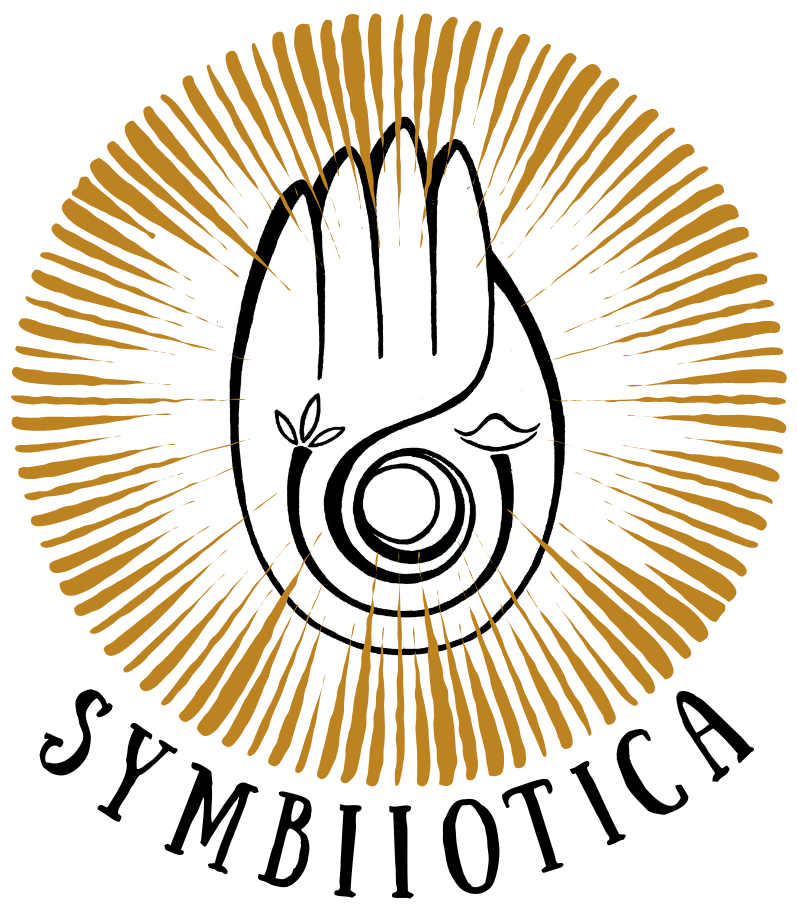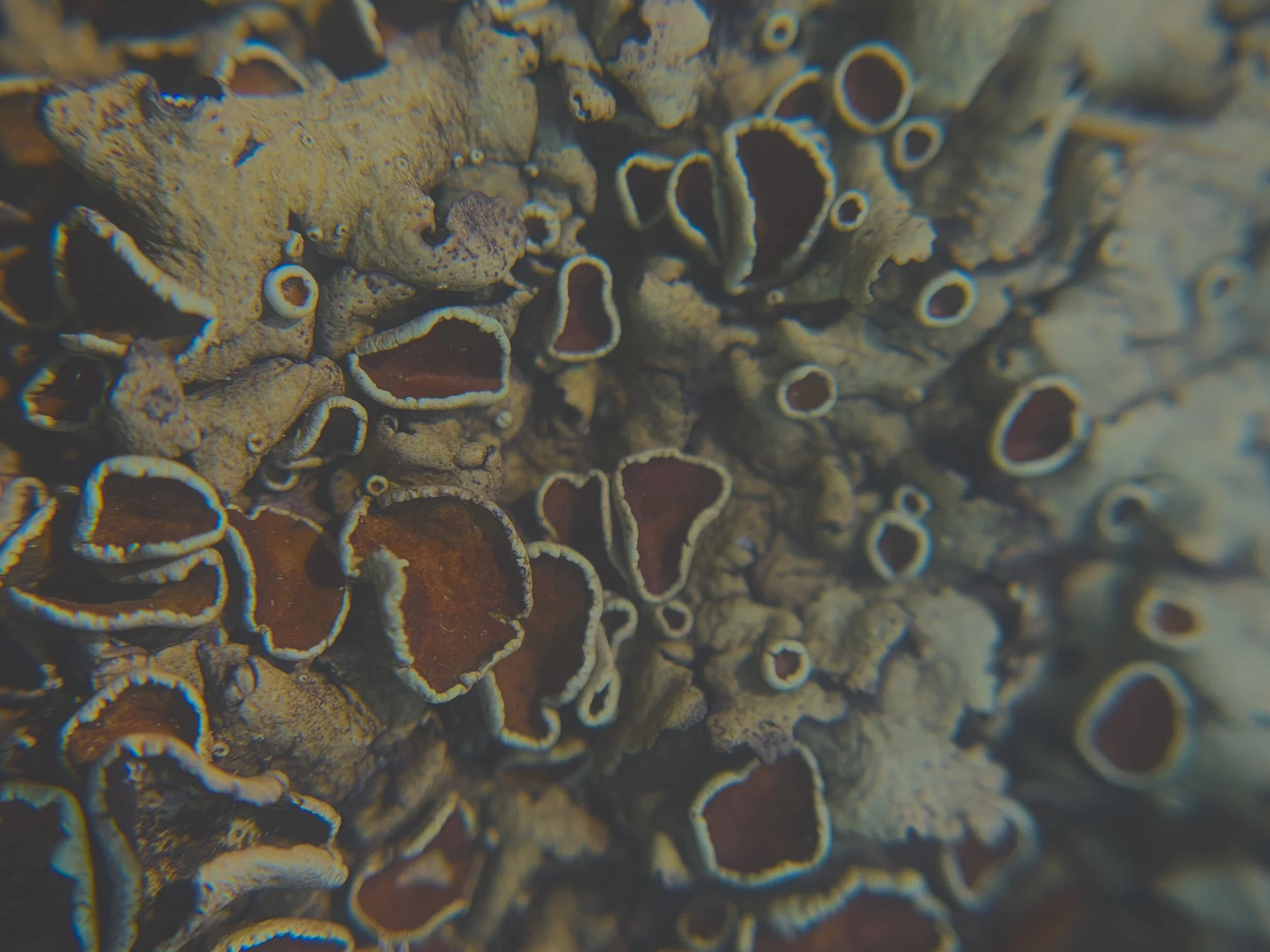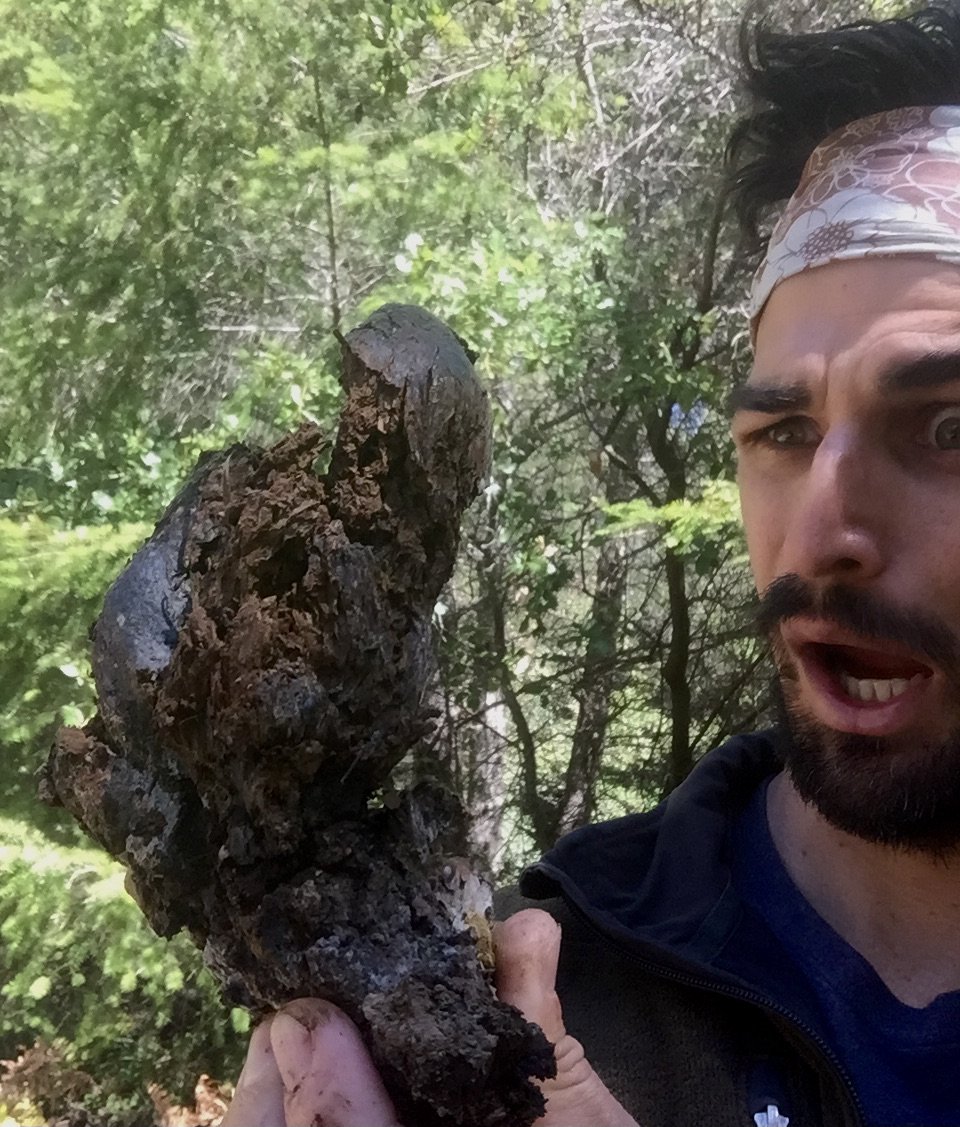Symbiiotica is a dynamic ecosystem of devotional offerings that honors the threads of planetary interdependence
Symbiosis evolved from the Greek words sumbiōsis “a living together,” sumbioun “live together,” and sumbios “companion.” Symbiosis is commonly defined as organisms living in close association with one another and their environment.
Therefore, symbiosis is the fundamental relational unit of all life.
From the dark, moist fungal-filled forest floor, to the high winds of the avian world, we are inextricably intertwined in the web of relations that create the conditions conducive to life.
Much like the rich humus, the gurgling spring head, the soaring turkey vulture and the unfurling fiddlehead, all beings and their respective ecologies are dynamically evolving and ever-unfolding processes. Stiched together with symbiotic sinew, these interactions are not stagnant but spectral, ranging from mutually collaborative to puzzlingly parasitic and everything in between.
Life is a complex amalgamation of billions of interdependent expressions and spirited stories continuously co-creating emergent properties and novel expressions. These properties then further cohere to create the diverse array of life as we know it: the fertile skin of our living Earth - much like what is unfolding on the surface of our skin, right now.
“We are biomes nested within biomes all the way down.”
We are being called like never before to slow down, to breathe deeper, to see with widened eyes and sharpened senses, to walk with gentleness and care alongside our human and more-than-human communities. How do we remember our humble place in the cyclical pulses of life, death, decay and renewal?
Nature is not “out there” or “somewhere to go.” Rather, nature is the messy, eloquent, unquantifiable force that gives life to form. Our very bodies and the sum of our experiences are enmeshed in the dynamic ecological tapestries of place.
In the tedious tipping point of present day, we stand upon the precipice of unforeseen ecological/societal collapse and a great churning back to the heart of interspecies altruism. This inevitably requires a tearing at the seams of the anthropocentric narratives and ideologies that have become walls around ourselves, attempts - but illusions - of safety.
“Fading Song” - Art by Tiffany Bozic
‘Invisible’ by Tiffany Bozic
We are a product of death, of sex, of extinction, of birth, of beauty, of bottlenecking and of rot. We have been given the gift of sensory organs billions of years in the making that grant us the ability to respond, a response-ability. What is our responsibility? How do we say thank you for all that Earth provides?
We believe it is our birthright and responsibility to cultivate the knowledge and skills to live in reciprocal relationship with soil, plants, fungi, animals, fresh waters, the sea, and all that gives rise to planetary homeostasis. Relishing in awe and gratitude for the gift of life we have inherited from our microbial and human ancestors is accessible to us all. May this also be the gift we uphold in service to our descendants.
“Mycelium Dreaming” - Art by Autumn Skye
“You are an evolutionary wonder, a trillion cells singing together in a vast chorale, an organism – environment, a symbiosis of cell and soul.”
About the creatures holding the vision of Symbiiotica:
Taye Bright (she/her, they/them)
I am a mycologist, naturalist, artist and all-around biophile passionate about fungal ecology, plant-fungal symbioses, bioremediation, ethnomycology, community science and conservation. I am especially interested in allying with fungi to encourage ecological literacy, create life-ways in alignment with bioregional intelligence and uplift cultural narratives that encourage interspecies reciprocity.
I holds B.S. in Biology and Environmental Science, certifications in Permaculture Design and Ecosystem Restoration Design, and am a certified UC California Naturalist.
I work for the Fungal Diversity Survey (FUNDIS), the only nonprofit focused on North America’s fungal biodiversity and conservation. There, I serve as a field mycologist for the California Fungal Diversity Survey and as co-coordinator for the West Coast Rare Fungi challenge.
I am also a post-fire bioremediation researcher for the Fire Ecology Network in X-Site Study (FENiXS), a climate adaptation study investigating the effects of microbial and fungal inocula on community resilience and ecosystem recovery.
Outside of my research, I lead classes, courses, workshops and walks around California and beyond, focusing on increasing accessibility of mycological and ecological education outside of conventional academia.
My involvement in community mycology is vast. I am the Education and Outreach coordinator for CoRenewal, on the Conservation and Stewardship committee for the North American Mycological Association, and sit on the board of directors for the Sonoma County Mycological Association and Bay Area Applied Mycology. I am also a member of the Mycological Society of America.
I am is the foundress of Symbiiotica (welcome!), a small business offering mycological consultations, eccentric art, nature-inspired poetry and wildcrafted fungal/botanical medicines. I have been crafting both wild harvested and cultivated botanical/fungal medicine for seven years and have been making art since I could hold a pencil.
I have six years of experience cultivating mushrooms and am a co-owner and operator of a small mushroom-growing mycoforestry project called Moon Fruit Mushroom Farm.
I believe my work in this world is to open doors of curiosity and widen the ecological perspective of the collective. I strives to help others tune into the vast microcosms of our living Earth and to illuminate the importance of inter-species relating.
Outside of my mycological work, you can find me in the garden talking with birds, experimenting with mushroom inks and dyes, making puzzles, surfing in Pacific waters, reading Nordic mythology and writing nature-inspired poetry.
“In my perspective, fungi are potent symbols of symbiosis - there is nothing in this life that they don’t influence in some way. I work with fungi not just for the fungi themselves, but as a means to illuminate what I believe they offer us - teachings that reside at the intersection of ecological, social, cultural, emotional, psychological, mythological and spiritual wisdom.”
“I would look up at the blue sky and ask that I be a reflection of all that I saw in nature, so that when people looked at me, they would see the fields and the wild flowers and the depth of the sky in my eyes.”
-Rosemary Gladstar
With one of my many “favorite” mushrooms, Hygrophorus eburneus, the cowboy’s handkerchief, which will likely get a new binomial someday.
Ryath Fujita Beauchene (He/him/they/we)
Hello Earth-internet beings and readers. I prefer “we” in that we are all composing and recomposing ecologies. “We?” someone asks when there’s no one else around. “Yes, me and my microbes,” I say, if only referring to “myself.”
I think if we used this pronoun more often, especially when upset at someone or intentionally/unintentionally alienating someone/something, we might better build our empathy and ability to honor others’ processes as valid and even parallel to our own. That said, yes, of course membranes and differentiation still matter, a lot.
I started studying fungi, plants, soil and the interactions of said processes around 16 years ago. It is fair to say these pursuits have thoroughly inculcated my ways of being and relating to everything.
I studied ecology and environmental education at Sonoma State University where I received an interdisciplinary BA engaging the cross-sections of outdoor leadership and ecological translation. Now that I know some more, I don’t understand how I received a degree in “ecology” without studying fungi. So I work to make sure mycology is a more recognized topic. I didn’t think I would use my degree in my income-related play (some people say “work”), but we have a funny way of failing to recognize alignment sometimes.
I know that fungi have positively tweaked my brain to think differently. They feed me in more ways than as food and medicine combined. They have changed my life forever, and I continuously work to find ways to say thank you to them. They also brought Taye into my life, and for that I am ever-indebted. I also know they have a lot to teach us humans, so I am their humble student and attempting translator.
As such, I have grown into the titles of mushroom seeker, cultivator, and mycocentric ecological educator. I co-steward our log-only outdoor mushroom farm, co-facilitate our mushroom walks/spells/outings/adventures/jaunts (please, not forays) and mushroom cultivation workshops as well.
I’m also a trained horticulturist, tree pruner, medicine maker, estate manager, and mycological consultant for mushroom growers and wellness formulations (adaptogens, omg!)
This might be a mushroom, depending on your definition of the word.
Peering under the skirt of the prince, Agaricus augustus.
I am curious and enchanted by the world and its myriad expressions, hooked on this life through the lenses of nutrition, ecology, fungi, plants, soil, semantics, scuba diving, endosymbiosis, herbalism, photography, cooking, regenerative pyromania and the maintenance of human-made thingamajigs.
It is one of my great hopes that someday we will realize that separateness and isolation are human-constructed illusions, the interconnected reality of every process we call a thing is literally immeasurable, unquantifiable and that love will live forever in the infinite universe.
We reside on the ancestral and contemporary homelands of Coast Miwok and Southern Pomo tribal nations, and we acknowledge the living stories embedded in the land, waters, forests, grasslands, stones and bones of this place. These communities, (currently represented by - but not limited to - The Federated Indians of Graton Rancheria) who have called this place Home for hundreds of generations before us, are the original and contemporary human stewards of these dynamic ecologies. Since time immemorial they have lived and grown in relationship with the water, fire, soil, sky and the surrounding non-human assemblages of animacy - and they continue to do so today. The fecund, diverse landscapes which provide such an abundance of food, medicine and textiles from which we benefit is an ongoing birth and legacy from generations upon generations of their tending hands. We tread lightly knowing that as descendants of “mixed-race” & European settler ancestry, we have a lot to learn about being of place and how to pay respect, give thanks, grieve, and truly honor the unfolding story of this land and all of its participants.
This being said, land/people acknowledgements are just a small step in the ongoing necessary process of repair, healing, reconciliation and building/bridging relationships. Whenever you are reading this from, we invite you to take a moment, reflect on the Indigenous peoples of the place you call home. How can you learn more about them, their culture, their stories of past and present, and most importantly, what you can do to support your local Indingeous-led organizations, projects and movements?
If you are living in or around the “Bay Area California”, here is a (far from exhaustive) list of Indigenous-led organizations and projects you could consider researching and supporting:
Petition to Protect Pomo Homelands & Redwood Forests
Protect Juristac & Petition to Santa Clara County: Protect Amah Mutsun Sacred Grounds from Proposed Quarry
Bay Area American Indian Two-Spirits (BAAITS)
Walqaqsh California Native Seed Store
Please inquire about how we are supporting local Indigenous organizations through our organization and how you can get involved!














